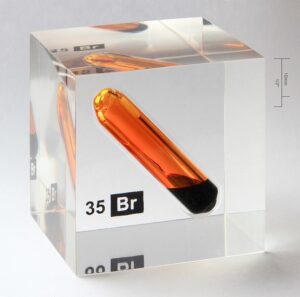
Bromine 28013020CAS
EC number
231-778-1
Min. purity / concentration
99%
Appearance
Liquid
Product Description
Bromine (chemical symbol: Br, CAS number: 7726-95-6) is a halogen element with an atomic number of 35. It is a reddish-brown liquid that has a strong, irritating odor and is highly reactive.
Technical details of Bromine:
• Molecular weight: 79.904 g/mol
• Melting point: -7.2 °C (19 °F)
• Boiling point: 58.8 °C (137.8 °F)
• Density: 3.1028 g/cm³
• Solubility in water: 3.41 g/100 mL (25 °C)
• Solubility in organic solvents: soluble in carbon disulfide, chloroform, and carbon tetrachloride
• Bromine is a powerful oxidizing agent and is used in the production of flame retardants, pesticides, and pharmaceuticals.
• It is also used in the production of brominated flame retardants and brominated vegetable oil, which is used as an emulsifier in citrus-flavored soft drinks.
• Bromine is highly toxic and corrosive and should be handled with care. It can cause skin and eye irritation, and inhalation of its vapors can lead to coughing, shortness of breath, and chest pain.
• Bromine is a chemical element that belongs to the halogen group and has the atomic number 35. It is a highly reactive, reddish-brown liquid that easily evaporates at room temperature to form a reddish-brown vapor. Bromine has a strong, unpleasant odor and is corrosive to skin, eyes, and mucous membranes.
• Bromine is mainly used in the production of flame retardants, which are added to plastics, textiles, and electronics to make them less flammable. It is also used in the production of pharmaceuticals, dyes, and photographic chemicals. In addition, bromine is used as a disinfectant in water treatment and as an intermediate in organic synthesis.
• Bromine has several isotopes, with bromine-79 being the most abundant. It is produced through the reaction of brine (sodium chloride solution) with chlorine gas or chlorine dioxide gas. The resulting mixture is then purified by fractional distillation to obtain pure bromine.
• Bromine is a highly reactive element and should be handled with care. It should be stored in a cool, dry place away from heat, sparks, and flames. Protective clothing, including gloves and goggles, should be worn when handling bromine.
• In conclusion, Bromine is an important element used in various industrial applications, including flame retardants, pharmaceuticals, dyes, and water treatment. Its highly reactive nature requires careful handling and storage to ensure safety.
Physical Data :
· Appearance: Dark Red Liquid
· Melting Point: -7.2 C
· Boiling Point: 58.8 C
· Vapour Density: 7.14
· Vapour Pressure: 175 Mm Hg At 20 C
· Specific Gravity: 3.119
Stability:Stable. Incompatible With Reducing Agents, Alkali Metals, Powdered Metals, Steel, Iron, Copper, Organic Materials.Toxicology:May Be Fatal If Inhaled. Highly Toxic By Inhalation, Ingestion Or Skin Contact. Causes Severe Burns. Lachrymator. Typical Tlv 0.1 Ppm. Typical Stel 0.3 Ppm.
General description
Bromine is present in gaseous form in lower atmosphere generated by marine activity and as a by product produced from the leaded gasoline combustion. It is widely used as a brominating agent.
Application
Bromine may be used as one of the reactants in the preparation of:
• quinones
• α,β-dibromosuccinic acid
• (Z)-ethyl 2-bromo-5-(trimethylsilyl)pent-2-en-4-ynoate
• α,α′-dibromo-2′,4′-dinitro-2(or3 or 4)-(acetyloxy)bibenzyls
• dibenzylnaphthols
Bromine may be used to catalyze:
• Aziridination of olefins with chloramine-T to form N-tosyl aziridines.
Conversion of epoxides and CO2 to cyclic carbonates in a continuous flow system

